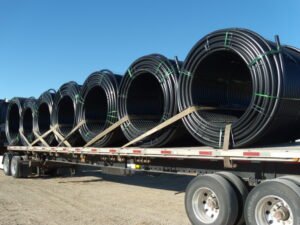
HDPE Water Pipes
Meeting the challenges of the 21st century Piping made from polyethylene is a cost-effective solution for a broad range of piping problems in municipal, industrial, marine, mining, landfill, duct, and agricultural applications. It has been tested and proven effective for above-ground, surface, buried, slip-lined, floating, and sub-surface marine applications.
High-density polyethylene pipe (HDPE) can carry potable water, wastewater, slurries, chemicals, hazardous wastes, and compresses gases. Infact, polyethylene pipe has a long and distinguished history of service to the gas, oil, mining, and other industries. It has the lowest repair frequency per mile of pipe per year compared with all other pressure pipe materials used for urban gas distribution.
Polyethylene is strong, extremely tough, and very durable, Whether You are looking for long service, trouble-free installation, flexibility, resistance to chemicals, or a myriad of other features, a high-density polyethylene pipe will meet all your requirements

HDPE Pipes Standards
- DIN 8074 & 8075
- ISO 4427 & 4437
- ASTM D2447 & F2160
- ASTM D2239
- ASTM D2737
- ASTM D3035
- ASTM D2513
- PS 3580
Advantages of using Kawsar HDPE Water Pipes
- Corrosion resistance. Do not rust, rotor corrode.
- Leak tight. Heat-fused joints create a homogenous, monolithic system. The fusion joints is stronger than the pipe.
- Excellent water hammer characteristics. Designed to withstand surge events.
- High strain allowance. Virtually eliminates breakage due to freezing pipes.
- Additional cost savings are achieved by lower instances of repairs.
- With no exfiltration or infiltration, portable water losses and groundwater nuisance treatment costs encountered in traditional piping systems are eliminated.
Polyethylene's are divides into 3 groups
according to their densities as
Advantages of Kawsar UPVC Pipes
Mineral Build Up Resistance
Kawsar HDPE resist scaling and internals deposits. Chlorine Ressistaance HDPE exceeds the requirements of. ASTM F876 for chlorine resistance, when tested in accordance with ASTM F2023.
Freeze Resistance
Unlike HDPE and copper pipes, Kawsar HDPE PIPES will not split when frozen, if allowed to expand along its entire length. It will return to its original shape when thawed.
High Impact Resistance
Kawsar HDPE is more flexible than other piping materials, and will not crush, kink or collapse when proper backfill techniques are used. Kawsar also has high resistance to gouges or scratches and outstanding resistance to slow crack growth.
Ductilicity And Toughness
Polyethylene pipes and fittings are inherently tough, resilient, and resistant to damage caused by external loads, vibrations, and pressure surges such as water hammers. Even in cold weather polyethylene pipe is tolerant to handling and bending.
Leak Free
Polyethylene pipe is normally joined by hheat fusion. Butt, socket, sidewall fusion and Electro fusion create a joint that is as he pipe itself, and is virtually leak free. This unique joining method produces significant cost reductions compared to other materials.
Excellent Flow Characteristics
Because polyethylene is smoother than steel, cast iron, ductile iron, or concrete, a smaller PE pipe can carry an equivalent volumetric flow rate at the same pressure. It has less drag and a lower tendency for turbulence at high flow. It is made of superior chemical resistance and non-stick materials.
Corrosion, Abrasion, And Chemical Resistant
Polyethylene piping’s performance in mining, dredging, and similar applications proves it will outwear many more costly piping materials when conveying a variety of abrasive slurries. HDPE has excellent corrosion resistance and is virtually inert.
It does need expensive maintenance or cathodic protection. It offers better overall resistance to corrosive acids, bases, and salts than most piping materials, In addition, polyethylene is unaffected by bacteria, fungi, and the most “aggressive” naturally occurring soils. It has good resistance.
Lightweight And Flexible
Polyethylene pipe is produced in straight lenghths or in coils. Made from materials about one-eighth the density of steel, it is lightweight and does not require the use of heavy lifting equipment for installation. It reduces the need for fittings, is excellent in shifting soil, and performs well in earthquake-prone areas.
HDPE resists the effects of freezing and allows bending without the need for an excessive number of fittings. Since HDPE is not a brittle material, it can be installed with bends over uneven terrain easily in continuous lengths without additional welds or couplings.
Reduced Installation Costs
- Material of choice for. Used in directional boring, plowing, river crossings, pipe bursting, and slip lining.
- Fewer fittings due to pipe flexibility. The allowable bending radius of 20 to 25 times outside the diameter of the pipe.
- Lighter equipment is required for handling and installation than with metallic materials.
- Eliminates the need for thrust blocking. Heat-fused joints are fully restrained.
- Lightweight and longer lengths allow for significant savings in labor and equipment.
HDPE Pipe - Earthquake Simulatioin Tested
In addition to being tested during actual earthquakes throughout the US, Canada and the globe, Cornell University researchers simulated, on April 6, 2006, an earthquake’s effects on gas and water polyethylene (PE) pipes by exerting a 120,000-pound force on a 16-inch diameter, 35-foot-long pipe – the largest test of ground rupture effects that has ever been performed in a lab.
The PE pipe, buried three feet below the surface, did not break during the test, but the sand shifted, bulged and cracked and created webbed lines on the surface as the pipe bent. During real life catastrophes PE pipe can be expected to perform well, while other pipe materials will be far more susceptible to breakage and lapse of service.























